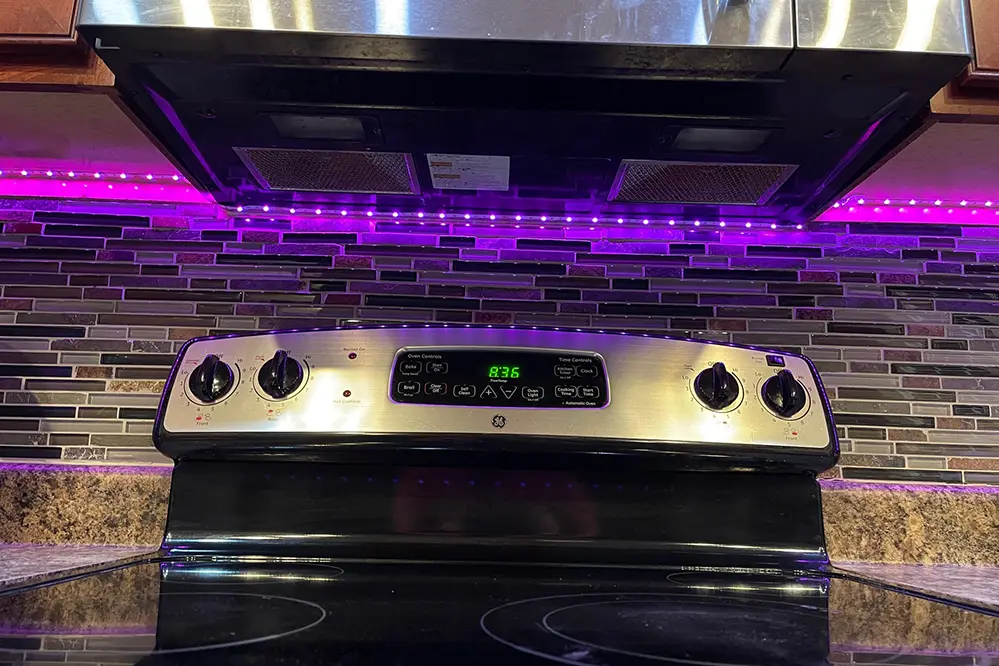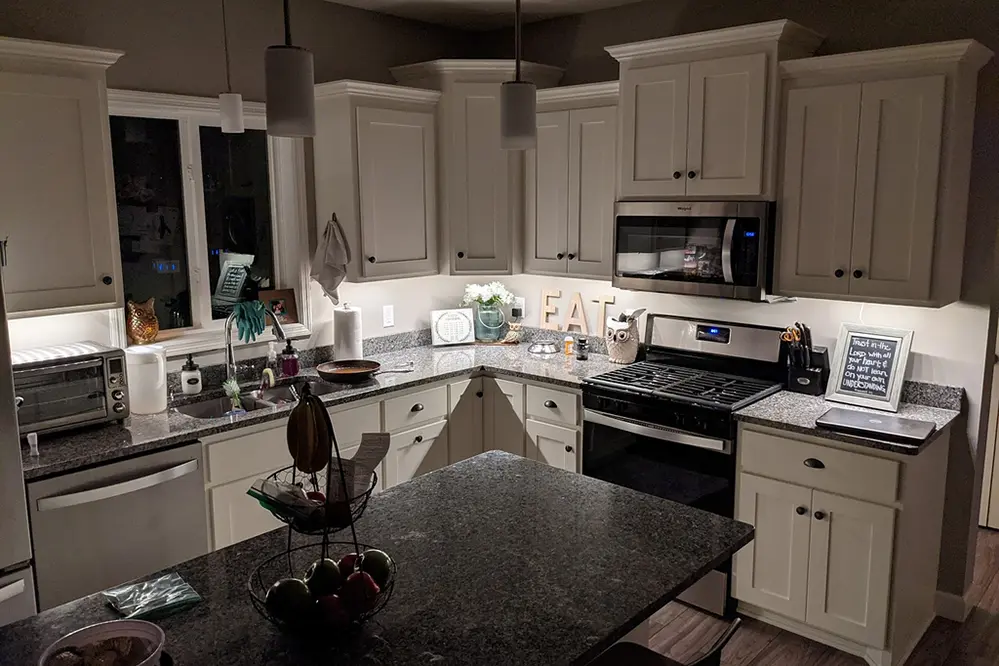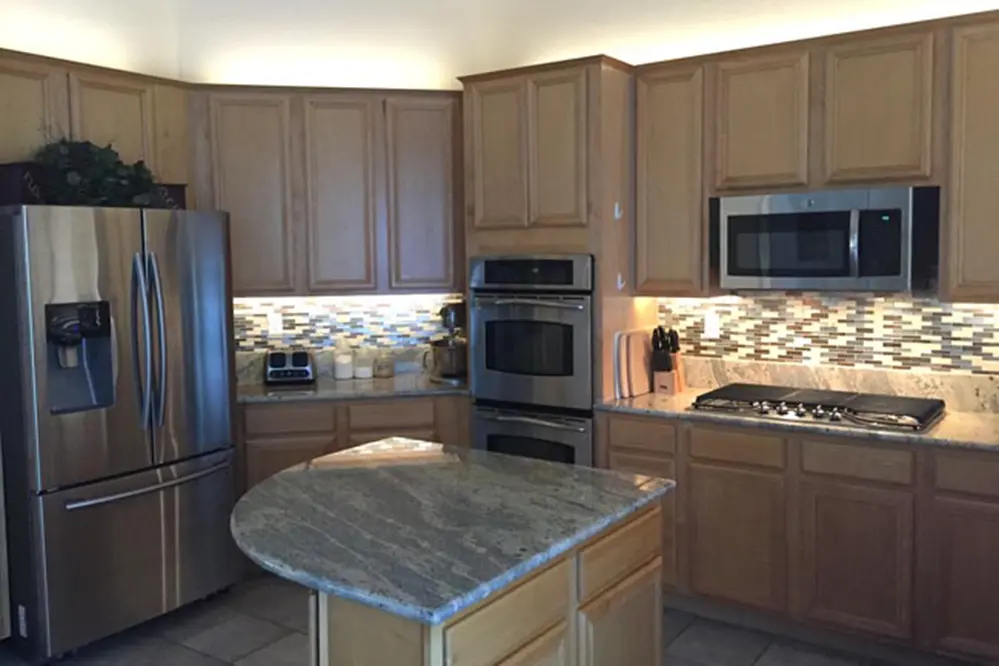Are you wondering if you can put LED strip lights above your stove? You’re not alone, and we’re here to provide you with the definitive answer. With our expertise, you’ll gain the clarity and confidence you need to make an informed decision.
You can install LED strip lights above your stove, but it is crucial to choose heat-resistant and waterproof options to ensure safety and longevity.
Read on to discover the best types of LED strip lights for this purpose, installation tips, and safety considerations to keep your kitchen both stylish and functional.
Pros and Cons of LED Strip Lights Above the Stove

When considering LED strip lights above your stove, a balance of advantages and considerations emerges. On the positive side, LED strip lights provide excellent task lighting, ensuring that your cooking area is well-illuminated. This enhanced visibility can improve not only the aesthetics of the kitchen but also the safety of food preparation. Additionally, the energy efficiency and long lifespan of LEDs make them an eco-friendly and cost-effective solution. However, it’s crucial to ensure that the LED strip lights are properly rated for high-temperature environments to avoid potential hazards. Careful installation and regular maintenance are key to maximizing both the safety and functional benefits of installing LED strip lights in this culinary hotspot.
Benefits of LED Strip Lights
LED strip lights offer a high degree of versatility—suitable for various lighting applications and enhancing the aesthetic value of any space.
LED strip lights consume significantly less energy, resulting in lower electricity bills and a reduced carbon footprint.
Moreover, they provide superior illumination and quality, ensuring that spaces are evenly lit without harsh shadows. This is particularly beneficial for critical tasks requiring precision and clarity, such as cooking.
In addition to energy efficiency and superior lighting quality, LED strip lights boast an impressive lifespan, reducing the need for frequent replacements. This makes them not only a convenient choice but also a wise long-term investment for any home.
Potential Drawbacks
While LED strip lights boast numerous advantages, they are not without their potential drawbacks, particularly when installed above a stove.
One of the primary concerns is heat.
Kitchens, especially around the stove area, are subject to high temperatures and humidity.
Prolonged exposure to these conditions may impact the longevity and performance of the LED strip lights.
Additionally, grease and cooking fumes can accumulate on the surface of the lights, leading to discoloration or possible malfunction.
Maintenance can become a recurring necessity, posing both an inconvenience and added expense.
Therefore, it’s essential to consider these factors and weigh them against the benefits when choosing to install LED strip lights above a stove.
Safety Considerations
When contemplating whether to install LED strip lights above your stove, safety considerations should occupy the forefront of your decision-making process.
In 2023, the National Electrical Code updated guidelines concerning the placement of light fixtures in high-temperature areas, reflecting the importance of adhering to these standards. As such, it’s crucial to ensure any LED strip lights above your stove are rated for high heat and humidity conditions.
Moreover, it’s imperative to address the potential for grease buildup. Regular exposure to cooking fumes can lead to a slippery, flammable layer of grease on the lights, increasing the risk of fire hazards. Opting for LED strip lights designed with protective coatings can mitigate these risks.
Additionally, installation must be performed by a licensed professional to ensure electrical safety and compliance with local building codes. Hardwiring the LED strips, rather than using plug-in options, can further reduce potential electrical hazards.
Considering these safety measures not only enhances the longevity of your LED strip lights but also ensures a safer kitchen environment.
Heat Resistance of LED Strip Lights
LED strip lights and heat resistance.
LED technology has significantly advanced over the years in terms of durability and functionality. These lights are often designed to withstand various environmental conditions, including reasonably high temperatures. However, placing them above a stove introduces unique challenges due to the intense, consistent heat typical in such areas.
Understanding the thermal limits of led strip lighting.
Most LED strip lights are designed to operate efficiently at temperatures up to about 140°F (60°C).
Evaluating kitchen-specific lights.
When selecting LED strip lights for installation above a stove, look for products that specify heat resistance up to 180°F (82°C).
In 2023, several manufacturers have introduced LED strip lights explicitly engineered for kitchen applications, offering superior heat resistance attributes. These products are rigorously tested to endure higher temperatures without compromising illumination quality or longevity, making them ideal for placement above stove areas. Prioritize these specialized options to ensure both safety and efficiency.
Moisture and Steam Impact
Placing LED strip lights above a stove exposes them to moisture and steam generated during cooking, which can significantly affect their longevity.
LED lights are built to handle specific levels of humidity and moisture exposure.
To mitigate potential damage, choose waterproof or water-resistant LED strips that have a rating of at least IP65. This rating entails protection against low-pressure water jets from any direction, thereby ensuring greater durability.
For ultimate performance, considering an additional layer of protection, such as a silicone coating on LED strips, might be beneficial. Regularly cleaning the lights to avoid buildup of moisture-related residues can further enhance longevity, ensuring your LED lighting solution remains efficient and reliable for years to come.
Installation Process
Installing LED strip lights above a stove requires careful planning and high-quality materials.
Firstly, ensure the LED strips you select are waterproof (IP65) to withstand the kitchen’s humid environment, thereby ensuring durability and efficiency. Additionally, position the power supply unit (PSU) away from the stove to minimize heat exposure.
Utilize adhesive backing and securing clips for optimal stability and long-lasting installation, ensuring the lights remain firmly in place.
Required Tools and Materials
Beginning your project requires a thoughtful selection of tools.
First, gather the essential tools for an efficient installation. You will need a measuring tape to accurately mark the placement of the LED strips, ensuring they fit perfectly above the stove. Additionally, a pair of scissors will be necessary for cutting the strips to the desired length. It’s important to have a screwdriver or drill for securely fastening the power supply unit.
Precision is key to achieving a professional finish.
You’ll also need adhesive tape and securing clips to firmly affix the strips, providing additional stability. Make sure to have a wire stripper handy for terminating wires, if required in your setup.
Finally, consider safety as a top priority. It is advisable to have protective gloves and eyewear to safeguard yourself during the installation process. With these tools and materials, you’re well on your way to creating an impressively lit kitchen space.
Step-by-Step Guide
To begin, ensure the power source where the LED strips will connect is turned off, providing a safe environment to work in. Safety first, always!
Next, measure the desired area above the stove where you plan to install the LED strip lights. This ensures precision.
Once measured, cut your LED strips to the appropriate length with your scissors, following the manufacturer’s guidelines. Cutting points are usually indicated.
Then, if your LED strip requires it, use the wire stripper to prepare the ends of the wires for connection. Properly prepare both ends.
Attach the adhesive tape to the back of the LED strips, or use securing clips if additional stability is needed. This guarantees a sturdy installation.
Finally, connect the LED strip lights to the power source and turn them on. Verify all connections are secure to ensure optimal functionality and a beautifully illuminated kitchen workspace!
Ideal Placement for LED Strip Lights

When pondering the placement of LED strip lights above your stove, several strategic factors should guide your decision. First and foremost, consider the area directly above your stove or range hood.
Positioning the lights here not only highlights the most frequently used area but also enhances safety. Illuminating the workspace ensures precise cooking.
Additionally, adhere to manufacturer safety recommendations to avoid excessive heat exposure. This precaution extends the lifespan of your lights.
Ensure that the chosen location does not obstruct ventilation. Proper ventilation is vital for both your kitchen and the longevity of your LED strips.
Coordinate with existing lighting fixtures to create a harmonious ambiance. The goal is a seamless integration that enhances the overall aesthetic of your kitchen.
Lastly, think about how the lighting will interact with your cooking habits. Select placements that best support your culinary endeavors and provide optimal visibility.
Mounting Locations Above the Stove
When considering potential mounting locations, it’s crucial to prioritize both functionality and aesthetic appeal. Ensuring that your LED strip lights are strategically placed will make your kitchen both safer and more visually pleasing.
For instance, mounting LED strip lights on the underside of your range hood can be particularly effective. This placement provides direct illumination over the cooking area, enhancing visibility.
Additionally, mounting on the adjacent wall above the stove offers another viable option. It merges functionality with design, illuminating the cooktop while enhancing the kitchen’s ambiance.
Further, you might consider placing the lights on a recessed ceiling fixture directly above the stove. This can distribute light evenly across the cooking surface.
Remember to maintain an adequate distance from the stove to prevent heat damage. LED strip lights are more resistant to heat, but caution is still essential.
Ultimately, the best mounting location aligns with your kitchen’s layout and your cooking preferences. Each option can be tailored to fit your unique needs and elevate your kitchen experience.
Conclusion
Yes, you can.
Incorporating LED strip lights above your stove can revolutionize your cooking space. Not only does it significantly enhance visibility, but it also elevates the aesthetic appeal of your kitchen. Strategically placed lights can create a safer, more functional cooking environment, while also serving as a striking design element.
Safety remains paramount.
Select high-quality, heat-resistant LED strip lights specifically designed for kitchen use. Ensure any wiring and power sources are safely out of the heat range, and opt for waterproof versions if available.
By combining practicality with design innovation, you can transform your kitchen into a modern cooking haven. Choosing the optimal placement for your LED strip lights will allow you to personalize your kitchen while maintaining functionality and safety.





